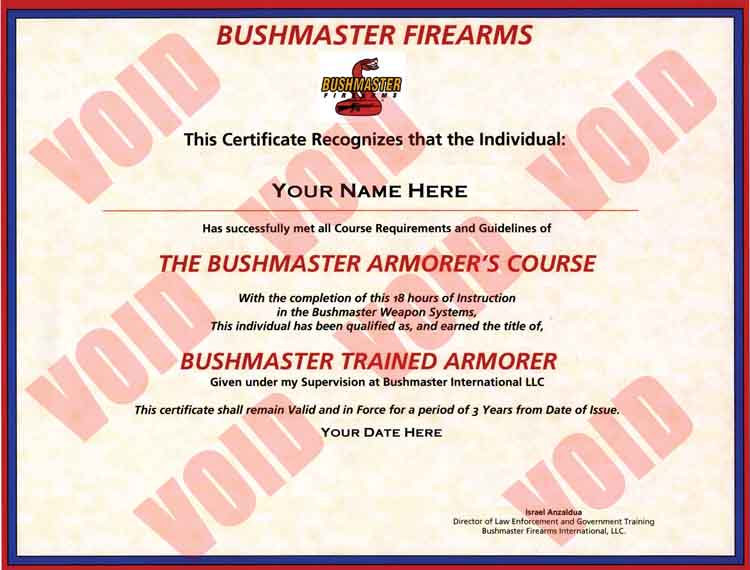Many readers of Small Arms Review are fans of the famous “Black Rifle.” Since the AR-15/M16/M4 and it’s numerous configurations and designations has been the primary service weapon of the United States for almost 50 years, it is well known in the military firearms community. In the last few decades it has been heavily altered, modified, improved and marketed to the civilian marketplace in enormous numbers. What was once a “Plain Jane” semiautomatic version of a basic battle-rifle, built and sold by just a handful of specialty manufacturers, is now available in numerous calibers and configurations by many familiar companies, previously specializing in more traditional sporting arms. This once obscure, special purpose rifle has become arguably the most popular firearms platform sold in the United States today.
One manufacturer that has been in the black rifle business for over 30 years and still going strong is Bushmaster Firearms International, LLC. They have been located in Maine for much of this time, and have become a benchmark for quality AR-15/M16/M4 style firearms and accessories. Their flagship component has been the high quality of their barrel systems for numerous years. (You can read about their exhaustive quality control and a full Industry Profile in the January, 2006 (Vol.9 No.4) issue of Small Arms Review, titled Birth of a Black Rifle.)
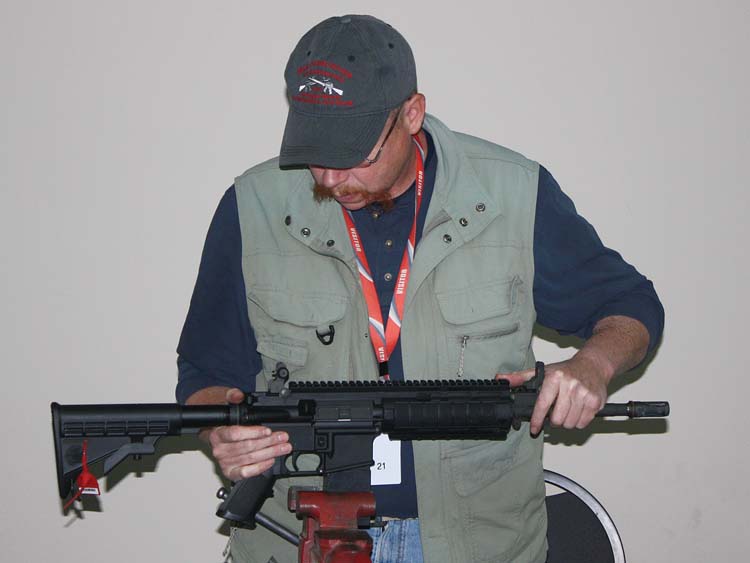
For a number of years, Bushmaster has offered an armorers course to qualified end users to become a Certified Bushmaster Armorer, and at their invitation to attend the course, we immediately agreed.
Far Beyond the Basics
The Bushmaster Armorers course is an 18-hour class available to police department, government, military armorers and other qualified individuals as a mechanism to be intimately familiar with their weapon system and to have the ability to keep their firearms properly maintained and operating correctly. Anyone attending, and paying attention, can expect to leave with enough knowledge to not only properly keep their guns up and running, but also to completely build a set of stripped receivers into a functioning firearm with little effort. Class topics include the following:
- History and Development of the Black Rifle
- Operating Principals
- Technical Specifications
- Parts Identification and Basic Function
- Complete Disassembly / Component Inspection / Reassembly
- Function Checks and Proper Gauging, including Headspacing
- Troubleshooting / Testing / Malfunction Diagnosis
- Proper Lubrication Procedures
Let the Learning Begin
Upon arriving at the Bushmaster Firearms International headquarters we were each provided with a complete set of armorer’s tools, a manual, and each student was issued a firearm. The students were introduced to the instructor, Israel Anzaldua, and given the opportunity for a brief introduction of each student.
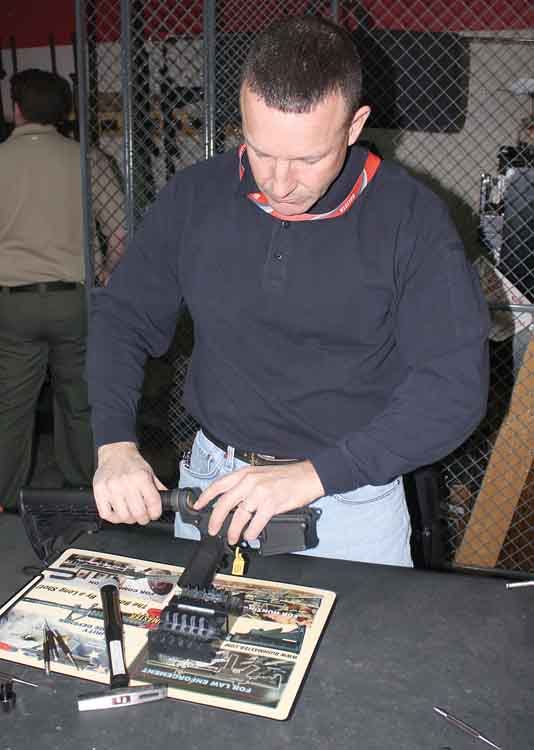
Immediately following the formalities it was time to get down to business. After a lengthy discussion about the history of the Black Rifle and its predecessors, we learned about the history of Bushmaster Firearms. From that point forward it was all down to business unless we were at break.
With each firearm cleared and the classroom void of any live ammunition, the weapon system was slowly and methodically disassembled, piece-by-piece with a detailed explanation and sometimes-lengthy discussion of each part and the role it plays.
After the firearm was completely disassembled, it was laid out in a manor similar to a schematic drawing where each component group could be assembled outside of the firearm to learn it’s inner workings without the obstructed view it has when assembled inside the completed rifle.
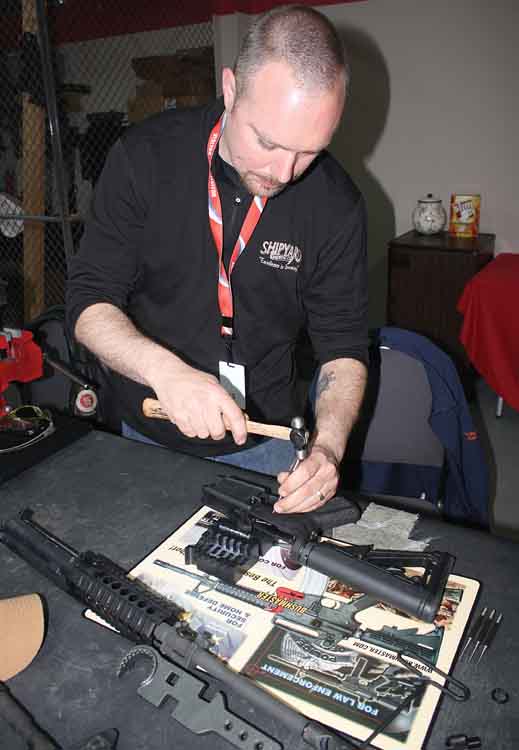
During the class it was clear when something would “click” with a student, as their face would beam with their newly found enlightenment. It’s one thing to explain something, and even to show a well-drawn illustration, but when you can actually watch, and in some cases feel, everything work, in conjunction with the other parts in an unobstructed way, AND it’s accompanied with a clear explanation, everything seems to fall into place. What were previously parts and pieces now become an integral mechanism that the students can clearly understand far beyond their earlier expectations.
Reverse Direction
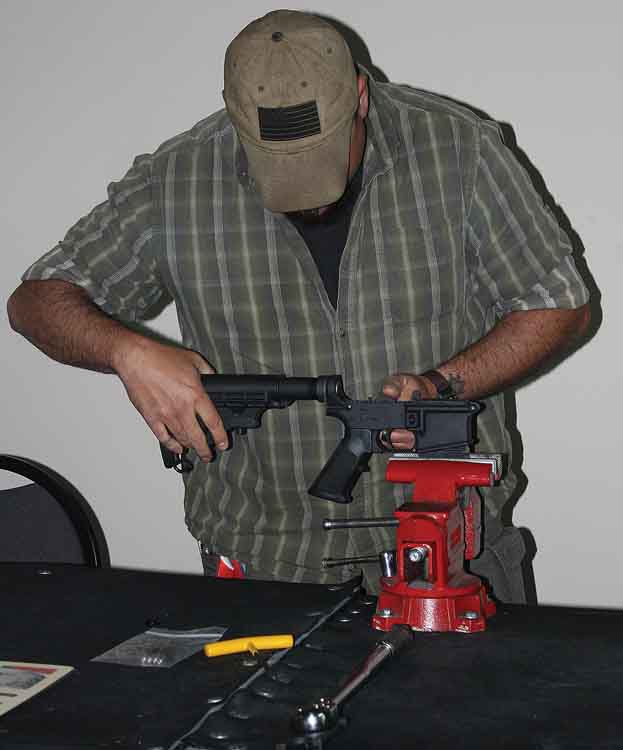
Once all the firearms were completely disassembled, (yes, completely, including dust covers, bolt catch assemblies, etc.) and their individual parts and pieces were fully understood, it was time to reverse course and reassemble into a properly functioning firearm. With each small piece falling into place, becoming part of the system, the learning continued. This pace was kept up until each student had reassembled their issued firearm to an equal or greater tolerance than they received it in.
With each step, just as in the disassembly phase, every part was explained in relation to its role in the system. This is where some excellent learning opportunities arose for some of the very advanced students in the class. While some students were building their first black rifle, others had assembled and worked with several. Even those who were very advanced found great benefit in the class early on, simply by learning to use the proper tools and specifications in the build. A few of the many topics and tips discussed in this phase included the following, commonly misunderstood subjects:
- Gas Key Staking
- Gas Tube Placement
- Barrel Nut Torque
- Captive Pin and Spring Insertion
- Lubrication Requirements
- Correct Break-In Procedures
Upon completing the reassembly phase it was time to perform a series of function checks and part gauging. Starting with the bolt and carrier, and all its components, and going completely through the receivers, stocks, sights and all other related parts, the entire rifle was checked, measured and gauged and followed up by a discussion of all the tap and thread sizes throughout the rifle.
Troubleshooting
After the firearms were reassembled and inspected it was time to learn some troubleshooting tips that would be beneficial in diagnosing future issues. Going through numerous malfunction drills, several failures were encountered followed by proper problem diagnosis and remedy. A few of those included, with several sub-sets of related issues, were:
- Magazine Problems
- Failure to Feed
- Double Feeding
- Improper Round Chambering
- Failure to Fire
- Failure to Eject
- Failure to Unlock
- Bolt-Hold-Open Failure
Upon covering more problems than most students had ever previously encountered, and learning to quickly diagnose and correct them, we concluded this portion of the lesson. After discussing and learning proper range procedures for live-fire exercises the class was dismissed.
Conclusions
In a post-action meeting after attending the Bushmaster Armorer’s Course, the sentiment was universal among all participants. The class was extremely beneficial to those of all previous skill levels. For the participants who categorized themselves more in an end-user capacity with very little prior technical experience it was a smash hit. Not only did they attain a much higher understanding of their preferred weapon system, but they all felt confident and capable of diagnosing and correcting their own problems as well as helping with their co-workers, teammates and friends. From their perspective, the veil of mystery had been lifted from the firearm they use on a regular basis, and a diagnosis they previously thought was “above their pay grade” was not only possible, but may be fairly simple.
For those participants with a great deal of time spent on and in the black rifle system, there was still much to take away from the class. Tips, tools and techniques for making disassembly, assembly and troubleshooting simpler were brought to light.
The vast experience and professionalism of our instructor was obvious from the first introduction, as Anzaldua was easily able to relate to the entire class; from those with little experience to the more seasoned students, without skipping a beat and never talking above anyone’s comfortable ability to learn. Another thing that deserves mention is that all tools that are used in the class are available to purchase directly from Bushmaster. Some of us who have been working on these rifles without the correct tools in the past may leave this course feeling a little bit “outgunned” in the workbench department after using the proper tools for the specific jobs and want to work with them with more ease in the future.
All students were supplied with a Bushmaster Armorer’s Course Manual for future reference and frameable graduation certificate upon completion of the course. In order to remain qualified as a Bushmaster Trained Armorer the certification must be renewed in 3 years.
Regardless of the skill level of the participant, this writer can highly recommend the 18-hour Bushmaster Armorer’s Course. If you have a small department and your officers use any variation of the black rifle it would be money and time well spent to have your department armorer certified in this course. If you have a large department with an in-house tactical team using a variant of the black rifle, you may consider sending all team members to learn more about their primary long gun. If you are a competitive or recreational shooter and happen to be the “black rifle go-to-guy” for a number of fellow shootists, this class will be most helpful as well.
The Fine Print

The Armorer’s Course featured in this article is conducted as a service to Bushmaster law enforcement clients at no cost. There is no prequalification to attend this Level 1 Armorer’s Course. Those who would like to further their training can contact their advanced training division and sister company High Caliber Training located in Crawfordsville AR. For the Armorer’s Course discussed here Bushmaster would like at least 6 months lead time due to a busy training schedule. Those interested can log onto www.bushmaster.com and go to the “Training” bar for more information. On the home page, click onto “Schedule” for the current classes available in your specific area.
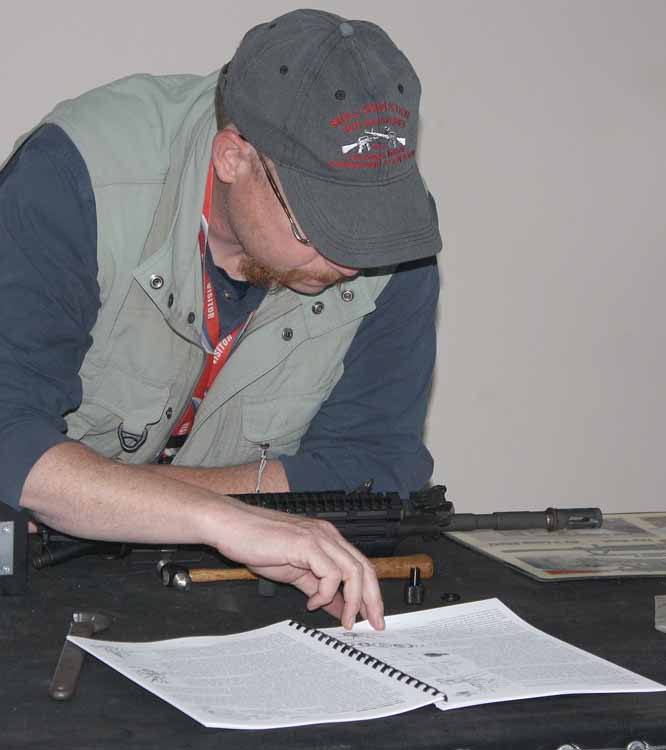
Meet the Instructor
We were fortunate to have Mr. Israel Anzaldua, the Director of Global Training & Technical Services, as our instructor this day. Israel Anzaldua has been a friend of this writer for over 20 years, and a very long time supporter of Small Arms Review magazine. He has been working at Bushmaster Firearms in numerous capacities for over 20 years and has been a key component in the business for much more than his humble ego will allow him to take credit for. Since he will not say it himself, we will: Anzaldua is a walking encyclopedia of all things Black Rifle and has a very deep understanding of the system. He is a long-time competitive and recreational shooter and his interest in this weapon system has spanned much longer than his exposure to both NATO and WARSAW Pac military weapon systems while in his service in the Army. Most importantly, Anzaldua is a likable, courteous, all-around good guy who really has a passionate interest in sharing his craft, and we were fortunate to have him as our instructor.
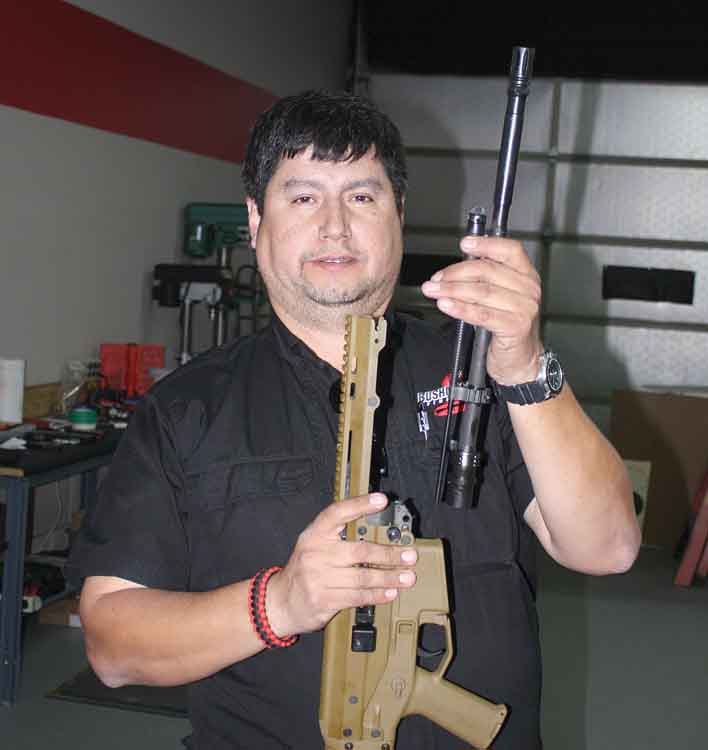
Bushmaster Firearms International, LLC
P.O. Box 1479
Windham, ME 04062
(800) 883-6229
www.bushmaster.com
High Caliber Training
3100 Angeletti Rd
Crawfordsville AR 72327
Phone: (877) 77HiCal
www.hicaltraining.com
info@hicaltraining.com
| This article first appeared in Small Arms Review V14N3 (December 2010) |



